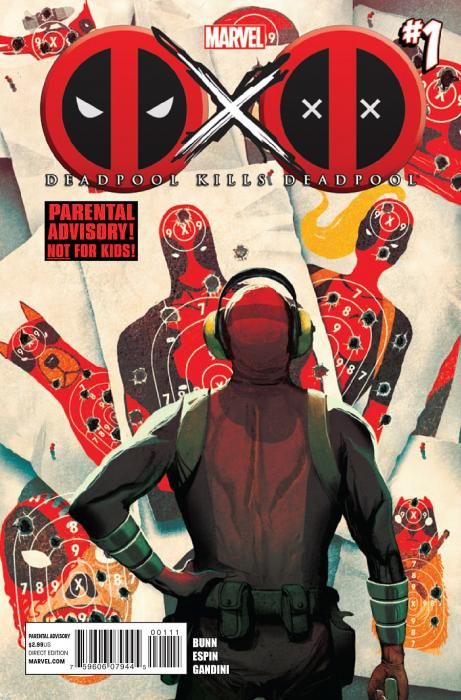"Deadpool Kills Deadpool" #1 by Cullen Bunn and Salva Espin, the Merc with a Mouth enters the final act of Bunn's "Deadpool Killology" that began with "Deadpool Kills the Marvel Universe" and "Deadpool Killustrated."
"Deadpool Kills Deadpool" #1 begins with a scene in which the villain, death-hungry black-clad Deadpool, warns Headpool/Zombiepool and the reader that "this might be hard for you to stomach." It's a gory scene, despite the pun and the creative use of a microwave. The over-the-top ick is only lightened by Espin's amusing background details and Headpool's usual unperturbed reaction to severe bodily injury.
This slightly grim teaser doesn't accurately convey the overall tone of the comic, though. Immediately afterwards, Bunn shifts the setting and the atmosphere from there on is more lighthearted. The regular Marvel Universe Deadpool takes over the action, quipping and chattering nonstop as always. The best dialogue in "Deadpool Kills Deadpool" occurs after the Bea Arthur ship arrives in a two-page spread, heralding the return of the Deadpool Corps, composed entirely of alternate-reality Deadpools. The scene feels like a warm family reunion. Lady Deadpool, Kidpool and fan-favorite Dogpool are joined by two more Deadpools.
Of course, Kidpool and Dogpool steal every scene, but kids and dogs traditionally have an advantage on the cute factor, and Bunn knows how to roll with that. The humor is bolstered greatly by Espin, who knows how to draw both cuteness and carnage with aplomb.
Bunn writes Kidpool and Dogpool to be endearingly emotional and earnest, which Espin reinforces by giving them extra visual energy and bouncy movements. Espin also works with the expanding cast well, and his facial expressions are excellent, especially considering that every single major character is masked. He relies only on the outlines of eye muscles and body gestures. One of the best moments is when Kidpool gets Deadpool to admit to that the Avengers wouldn't ever congratulate him for any heroism. Deadpool appears genuinely crestfallen in this panel, and the emotional effect is reinforced by the circular panel and the small text size in his dialogue balloons.
Characterization is limited in humor comics, but the effort that Cullen and Espin put into the Dogpool and Kidpool bond pays off. The "a boy and his dog" bond carries a lot of weight by itself, but Espin's art makes the emotions feel more genuine than just going through the motions for a joke.
Like Deadpool writers routinely do, Bunn breaks the fourth wall early and often. For comedy value, it's amusing but easily overused. Bunn's jokes rely heavily on the reader knowing Marvel Universe trivia, and they are cute and flip instead of sharp or satiric. Gandini's bright palette reinforces this upbeat tone throughout "Deadpool Kills Deadpool" #1. However, the toothlessness of the humor may be necessary to counter the structural darkness of so much repetitive death.
"Deadpool Kills Deadpool" is a natural concluding act for "Killology" as it follows the logic of the death-obsessed Deadpool. Bunn is taking a risk in having this motivation in his villain. While bodily injury is a staple of humor and death and homicide jokes are common, suicide is more difficult as a subject for comedy. Deadpool's continued appeal lies partly in his inability to be fazed by pretty much anything. It will be interesting to see if Bunn tackles those ideas head-on or skirts around them in future issues.
Speaking of themes and devices, the ending cliffhanger features a surprise appearance by a familiar Marvel Universe multiverse character who has a fun whack-a-doodle statement for the final panel. Bunn hints that Deadpool is as much about beginnings as endings. In this and in Espin's art, "Deadpool Kills Deadpool" #1 is an entertaining start to the last of "Killology."

